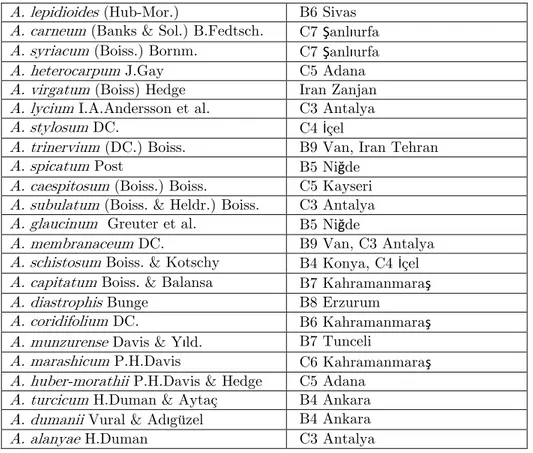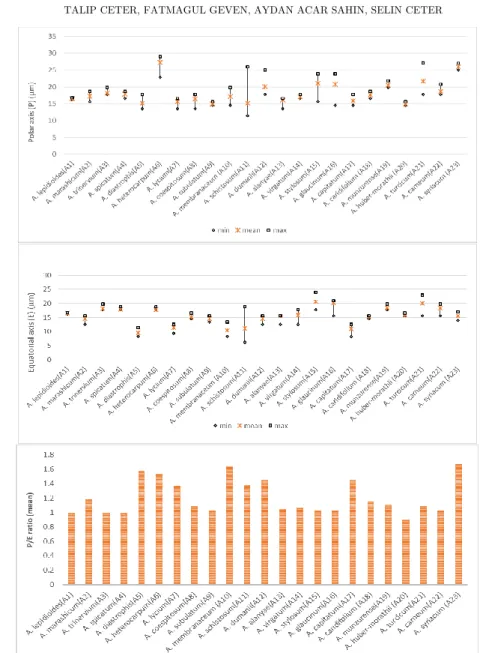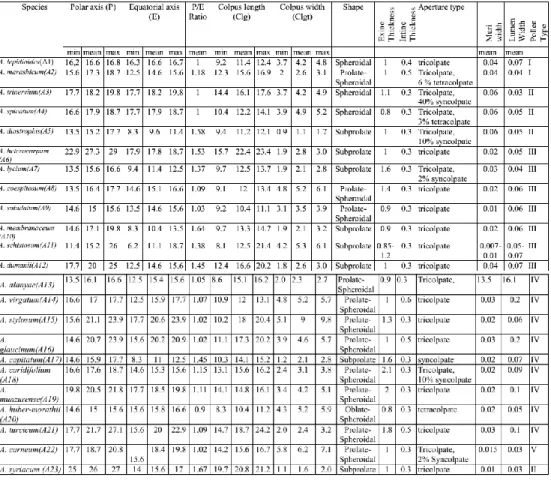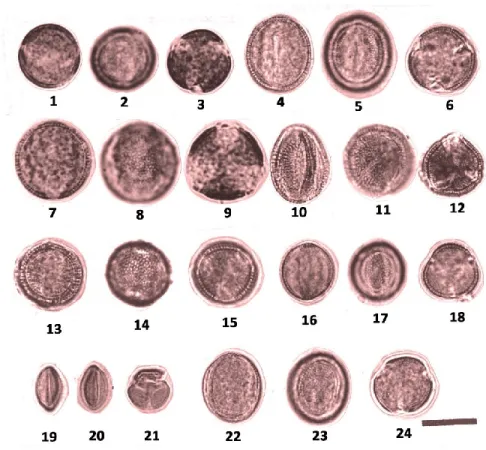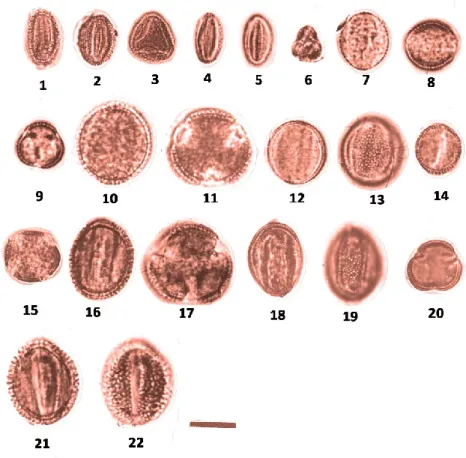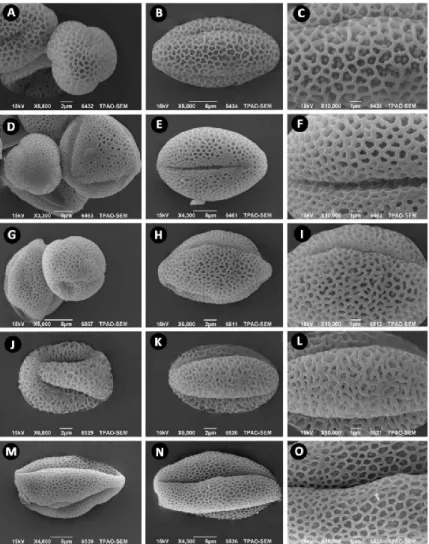Volume 27, Number 1, Pages 11-24 (2018) DOI: 10.1501/commuc_0000000188 ISSN 1303-6025
http://communications.science.ankara.edu.tr/index.php?series=C
Received by the editors: April 21, 2018; Accepted: May 04, 2018.
Key word and phrases: Pollen morphology, Aethionema, Brassicaceae, LM, SEM
© 2018 Ankara University Communications Faculty of Sciences University of Ankara Series C: Biology EXAMINATION OF POLLEN MORPHOLOGY OF SOME AETHIONEMA
(BRASSICACEAE), FROM TURKEY
TALIP CETER, FATMAGUL GEVEN, AYDAN ACAR SAHIN, AND SELIN CETER
Abstract. Pollen morphology of 23 species of taxonomically difficult genus Aethionema W.T.Aiton was examined by light microscopy (LM) and scanning electron microscopy (SEM). Pollen grains have showed significant variation in aperture number and type. Generally pollen is tricolpate, but
tricolpate-syncolpate, tricolpate-syncolpate-tetracolpate,
syncolpate-tetracolpate, or merely syncolpate apertures also occur and make a heteromorphic assemblage. Pollen shape is prolate, prolate-spheroidal, subprolate, spheroidal or suboblate, and pollen ranges from 9.4 to 29 µm (P), 6.2 to 23.9 µm (E). Five main pollen types were identified based on the sculpturing of the exine. The pollen shape, size, surface ornamentation, muri and lumina shape and size are found as important and useful features for distiguishing of the taxa.
1. Introduction
The genus Aethionema W.T.Aiton (Brassicaceae) has 75 species in the worldwide, of
which 31 species are endemic to Turkey [1,2]. Turkey is gene-center of the genus and
maintains 51 taxa [3,4,5,6]. Aethionema is a taxonomically difficult genus and few
macromorphological characters are available for species delimitation. Life span (annual or perennial) and fruit morphology are very importance at the species level [3]. Brassicaceae contains nectary plant taxa, and these are very important for honey bees [7].
Many researchers have emphasized the importance of pollen morphology for the Brassicaceae family [8,9,10,11,12]. İnceoğlu and Karamustafa (1977) was studied
the pollen morphology of Aethionema arabicum (L.) Andrz. Ex DC and A. armenum
Boiss. with light microscopy [13]. Atçeken (2016) studied pollen morphology of four
A. armenum) of genus [14]. Karaismailoğlu (2017) examined pollen morphology of
eleven Aethionema taxa (A. froedinii Rech. Fil., A. arabicum, A. eunomioides
(Boiss.) Bornm., A. fimbriatum Boiss., A. speciosum Boiss ssp. speciosum, A.
speciosum ssp. compactum, A. saxatile, A. oppositifolium (Pers.) Hedge, A.
iberideum (Boiss.) Boiss., A. armenum and A. grandiflorum Boiss. & Hohen.)
distributed in Turkey [15].
Our objective was to examine the pollen morphology of 23 Aethionema
species and determine the contributions of pollen morphology to taxonomy of the genus.
2. Material & Method
All pollen samples were taken from herbarium specimens in the GAZI collection. The voucher specimens are listed in the Appendix.
The pollen grains were studied by light microscopy (LM) and also by scanning electron microscopy (SEM) in order to investigate the exine sculpturing in detail. Pollen for LM was prepared by the methods of Wodehouse (1935) [16]. The LM studies were performed using a Nikon E-600 microscope. The following parameters were measured: polar (P) and equatorial (E) axis, colpus length (Clg) and width (Clt) and exine and intine thickness. For most specimens, the measurements of P (polar axis) and E (equatorial axis) represent the mean of 50 or more pollen grains, and of some 10 measurements for exine and intine thickness. The LM photographs were taken with a Nikon FDX–35 camera connected to a Nikon E-600 photomicroscope. For SEM, the air-dried pollen were covered with gold during exaporation prior to examination on the screen of a jeol electron microscope. Terminology follows that of Faegri-Iversen [17] and Brochmann [8]. The Simpson and Roe graphical test was used for graphical calculations [18]. The order of the species in the list adopted to Davis [19]. All samples have been deposited by Adıgüzel, N. in the Gazi University Herbarium. Specimens examined were given in Table 1.
Table 1. The information of specimens and localities
A. lepidioides (Hub-Mor.) B6 Sivas
A. carneum (Banks & Sol.) B.Fedtsch. C7 Şanlıurfa
A. syriacum (Boiss.) Bornm. C7 Şanlıurfa
A. heterocarpum J.Gay C5 Adana
A. virgatum (Boiss) Hedge Iran Zanjan
A. lycium I.A.Andersson et al. C3 Antalya
A. stylosum DC. C4 İçel
A. trinervium (DC.) Boiss. B9 Van, Iran Tehran
A. spicatum Post B5 Niğde
A. caespitosum (Boiss.) Boiss. C5 Kayseri
A. subulatum (Boiss. & Heldr.) Boiss. C3 Antalya
A. glaucinum Greuter et al. B5 Niğde
A. membranaceum DC. B9 Van, C3 Antalya
A. schistosum Boiss. & Kotschy B4 Konya, C4 İçel
A. capitatum Boiss. & Balansa B7 Kahramanmaraş
A. diastrophis Bunge B8 Erzurum
A. coridifolium DC. B6 Kahramanmaraş
A. munzurense Davis & Yıld. B7 Tunceli
A. marashicum P.H.Davis C6 Kahramanmaraş
A. huber-morathii P.H.Davis & Hedge C5 Adana
A. turcicum H.Duman & Aytaç B4 Ankara
A. dumanii Vural & Adıgüzel B4 Ankara
A. alanyae H.Duman C3 Antalya
3. Results
The main palynological features of the Aethionema species examined are summarized
3.1 Size, Symmetry and Shape
Pollen are isopolar, radialy symmetric. Pollen shape is prolate,
prolate-spheroidal, subprolate, spheroidal or suboblate; P: 9.4–29
m
; E: 6.2–23.9m
; P/E:0.82–1.67. Outline is elliptic or circular in equatorial view and usually semiangular, rarely more or less circular in polar view (Figures 2,3 and 4).
3.2 Apertures
The pollen grains are tricolpate, tetracolpate or syncolpate. The colpus is long, usually wide. Apertural membrane is generally psilate or rarely granular (Figures 2,3 and 4). Pollen grains of some taxa are surrounded by colpus (syncolpate pollen grains) (Figures 2,3 and 4).
Exine
Exine is semitectate with a reticulate sculpturing. Lumina are generally 0.1
m
or less than 0.1m
wide (Table 2). Lumina shape is irregular, elliptic orpolygonal (Figure 4). Muri is less than 0.01
m
thick. Exine thickness is 0.8–2.3m
.Ectexine is slightly thicker than endexine. Intine is 0.8–2.3
m
(Table 2). On the basis of reticulate exine sculpturing, 5 pollen types are recognised in the genusAethionema:
Type I: The pollen grains of this type have a characteristic, vermiculate
reticulation with relatively wide muri (mean 0.04
m
) and irregularly shaped lumina.This type was observed in A. lepidioides and A. marashicum (Figures 2, 3 and 4).
The species included in type I are characterised by tricolpate, spheroidal or prolate-spheroidal pollen grains (Table 2).
Type II: This type has characteristic pollen grains with wide muri (mean
0.06
m
) and regularly shaped lumina. This type was characterized bytricolpate-syncolpate aperture types and observed in A. trinervium, A. diastrophis and A.
spicatum (Figure 2, 3 and 4). All these species show heteromorphy.
Type III: Pollen grains have narrow muri (mean 0.025
m
) and widelumina (mean 0.05
m
). This type was observed in A. heterocarpum, A. lycium, A.caespitosum, A. subulatum, A. membranaceum, A. schistosum, A. dumanii and A.
Type IV: This type has characteristic pollen grains narrow muri (mean 0.025
m
) and polygonal lumina. This type was observed in A. virgatum, A. stylosum, A.glaucinum, A. capitatum, A. coridifolium, A. munzurense, A. huber-morathii and A.
turcicum (Figures 2, 3 and 4).
Various aperture types have been observed in this type: tricolpate (A. virgatum, A.
stylosum, A. glaucinum, A. munzurense and A. turcicum), tricolpate-syncolpate (A.
coridifolium), syncolpate (A. capitatum) and tetracolpate (A. huber-morathii) (Table
2). The pollen shape is often prolate-spheroidal or subprolate (Figure 3).
Type V: Pollen grains have narrow muri and irregularly shaped lumina.
This type was observed in A. carneum (Figure 2, 3 and 4) . The pollen type is
prolate-spheroidal (Figure 3) and tricolpate-syncolpate (Table 2). 4. Result & Discussion
The pollen of the Aethionema species examined in this study showed
considerable variations with respect to features such as the number and type of
apertures and thickness of muri and width of lumina. In Aethionema, 16 species were
found with merely tricolpate (A. lepidioides, A. marashicum, A. heterocarpum, A.
coespitosum, A. subulatum, A. membranaceum, A. schistosum, A. dumanii, A.
virgatum, A. stylosum, A. glaucinum, A. munzurense, A. turcicum and A. syriacum),
one with merely syncolpate (A. capitatum) and one with merely tetracolpate pollen
(A. huber-morathii). The other species were tricolpate-syncolpate (A. trinervium, A.
diastrophis, A. lycium, A. alanyae, A. caridifolium and A. carneum) (Table 2).
Rollins and Banerjee have observed that the most common pollen type in the family Brassicaceae is tricolpate with grooves varying in length in different genera [20]. In addition, tetracolpate form in the pollen of Dithyrea californica and pentacolpate
forms characteristic of many species of the genus Querella, Physaria and
Dimorphocarpa of Brassicaceae have been seen. Doğan and İnceoğlu also found
tricolpate, syncolpate, tetracolpate and pentacolpate grains in the genus Isatis L. of
the family Brassicaceae [21]. Tricolpate pollen grains of the species A. stylosum, A.
glaucinum, A. schistosum, A. turcica and A. dumanii show considerable variations
in pollen size (Table 2 and Figure 1). In each specimen of these species both 50% larger and 50% smaller pollen grains have been observed. Variation in pollen size and aperture type was attributed to heteromorphy in pollen grains by some researchers [22,23,24,25]. Heteromorphy is caused by either anomalies in meiosis [22, 26], colchicine [27,28], or hybridization [29,30].
Figure 2. LM pollen microphotograph of Aethionema taxa. 1–3: A. carneum, 1; Meridional, optical section, outline, 2; Aperture and ornamentation, 3; Polar view.
4–6: A. heterocarpum. 4: Meridional, optical section, outline. 5: Aperture and
ornamentation. 6: Polar view. 7–9: A. stylosum. 7: Meridional, optical section,
outline. 8: Ornamentation, 9: Polar view. 10–12: A. trinervium. 10: Meridional,
optical section, outline. 11: Aperture and ornamentation. 12: Polar view. 13-15: A.
caespitosum, 13; Meridional, optical section, outline, 14; Ornamentation. 15; Polar
view. 16-18: A. membraneceum, 16; Meridional, optical section, outline, 17;
Ornamentation, 18; Polar view. 19-24: A. schistosum. 19; Meridional, optical section,
outline, 20; Aperture. 21; Polar view, 22; Meridional, optical section, outline. 23; Ornamentation. 24; Polar view (Scale bar: 10 µm).
Figure 3. LM pollen microphotograph of Aethionema taxa. 1-3: A. capitatum, 1; Meridional, optical section, outline. 2; Aperture and ornamentation, 3; Polar view.
4-6: A. diastrophis, 4; Meridional, optical section, outline. 5; Aperture and
ornamentation, 6; Polar view. 7-9: A. coridifolium, 7; Meridional, optical section,
outline. 9; Syncolpate aperture, 9; Polar view. 10-11: A. munzurense, 10; Meridional,
optical section, outline. 11; Polar view. 12-13: A. marashicum, 12; Meridional, optical
section, outline. 13; Ornamentation. 14-15: A. huber-morathii, 14; Meridional, optical
section, outline. 15; Polar view. 16-17: A turcica, 16; Meridional, optical section,
outline. 17; Polar view. 18-20: A. dumanii, 18: Meridional, optical section, outline.
19; Ornamentation, 20; Polar view. 21-22: A. alanyae, 21; Meridional, optical section,
Figure 4. SEM pollen microphotograph of Aethionema taxa. A-C: A. marashicum
(type I), A; Polar view, B; equatorial view, C; ornamentation. D-F: A. trinervium
(type II), D; Syncolpate and tricolpate pollen in polar view, E; equatorial view, F;
ornamentation. G-I: A. schistosum (type III), G; Syncolpate pollen in polar view, H;
equatorial view, I; ornamentation. J-L: A. capitatum (type IV), J; Syncolpate pollen
in polar view, K; equatorial view, L; ornamentation. M-O: A. carneum (type V),
There has been no chromosomal study of the Aethionema species so far. Thus, future cytological studies in the genus may provide further information about heteromorphy
in pollen grains. İnceoğlu and Karamustafa investigated 32 Brassicaceae species
pollen grains and these were divided into 3 reticulate types, according to the diameters of the lumina (faintly reticulate, reticulate and coarsely reticulate), using LM [13].
Brochmann divided the genus Draba L. of the family Brassicaceae into 5
pollen types with respect to exine sculpturing resembling Aethionema in pollen
morphology. In this study 5 pollen types are recognised according to pollen exine sculpturing (types I, II, III, IV and V) These pollen type described as vermiculate reticulation with relatively wide muri and irregularly shaped lumina (Type I), reticulate pollen grain with wide muri and regularly shaped lumina (Type II), pollen grain have narrow muri and wide lumina (Type III), pollen grain of this type have narrow muri and polygonal lumina (Type IV), pollen grains have narrow muri and irregularly shaped lumina (Type V). Heteromorphic pollen grains are mostly observed in the species belonging to type IV [8]. İnceoğlu and Karamustafa described
the general pollen morphological features of A. arabicum and A. armenum using LM.
They described the sculpturing of these 2 species as faintly reticulate [13]. Karaismailoğlu, determined reticulate, microreticulate and coarsely reticulate exine
sculpturing in eleven taxa of Aethionema [15]. Similarly Atçeken et al. determined
reticulate and microreticulate ornamentation in four taxa of Aethionema [14]. In
addition, in a study which is about pollen morphology of 39 species belonging to 23 genera of the tribes Arabideae, Euclidieae, Hesperideae, Lunarieae, Matthioleae and Sisymbrieae from Brassicaceae from Egypt were studied by using scanning electron microscope (SEM), the pollen grains were tricolpate and their shape varies from prolate spheroidal, subprolate to prolate. Three pollen types can be distinguished based on the size of the lumina. The ornamentation varies between genera within the tribes and between species within the same genus [31].
This study results show that pollen shape, size, surface ornamentation, muri and lumina shape and size are important and useful characters contributing to the differentiation of the taxa.
Acknowledgements. We are grateful to the both Gazi University herbarium and Edinburgh herbarium for the opportunity to study some materials. We would like to thank Prof. Dr. Nezaket Adıgüzel (Gazi University Department of Biology), Doç. Dr. Barış Bani (Kastamonu University Department of Biology) and Prof. Dr. Nur Münevver PINAR (Ankara University Department of Biology) for her contributions and support in this study.
References
[1] I.C Hedge and J.M. Lamond . Aethionema R.Br. In: C.C. Townsend and E.
Guest (ed.), Flora of Iraq4 (1980) 915-922.
[2] Ş. Yıldırımlı, Ö. Kılıç, New infrageneric taxa and species of Aethionema
W.T.Aiton (Brassicaceae) and their current key from Turkey. Ot Sistematik
Botanik Dergisi 23(1-2) (1935-2016) 1-66.
[3] I.C. Hedge. Aethionema R.Br. In: Davis PH (ed.). Flora of Turkey and The
East Aegean Islands. Edinburgh: Edinburgh University Press. (1965).
[4] P.H. Davis, R.R Mill and K. Tan, Flora of Turkey and the East Aegean Islands 10. Edinburgh : Edinburgh University Press. (1988).
[5] A. Güner, N. Özhatay, T. Ekim and K.H.C. Başer. Flora of Turkey and The East Aegean Islands vol 11. Edinburgh: Edinburgh University Press. (2000). [6] A. Güner, S. Aslan, T. Ekim, M. Vural and M.T. Babac Türkiye bitkileri listesi
(damarlı bitkiler). A Checklist of the Flora of Turkey (Vascular Plants) Nezahat Gokyigit Botanik Bahcesive Flora Arastırmaları Dernegi Yayını, Istanbul. (2012).
[7] K. Sorkun. Türkiye’nin Nektarlı Bitkileri, Polenleri ve Balları. Ankara. Palme Yayınları (2008) 462.
[8] C. Brochmann, Pollen and seed morphology of Nordic Draba (Brasicaceae)
phylogenetic and ecological implications, Nordic Journal of Botany 12/6
(1992) 657-673.
[9] N.M. Pınar, A. Duran, T. Çeter and G.N. Tuğ, Pollen and Seed Morphology of the Genus Hesperis L. (Brassicaceae) in Turkey. Turkish Journal Botany (2009) 33(2) / 83-96.
[10] T. Çeter, N.M. Pınar, Y. Bağcı ve L. Tutar, Türkiyede yayılış gösteren Rorippa
Scopp. (Brassicaceae) türlerinin polen ve tohum morfolojisi. 20. Ulusal Elektron Mikroskopi Kongresi. Kemer/Antalya. Ekim 2011 25-28.
[11] T. Çeter, N.M. Pınar, Y. Bağcı and A. Savran, -Türkiyede Yayılış Gösteren
Barbarea (Brassicaceae) Türlerinin Polen Morfolojisi 21. Ulusal Biyoloji
Kongresi, Ege Üniversitesi, İzmir. (3-7 Eylül 2012).
[12] B. Mutlu and S. Erik, Pollen morphology and its taxonomic significance of the
genus Arabis (Brassicaceae) in Turkey. Plant Systematics and Evolution. 298
(2012) 1931–1946.
[13] Ö. İnceoğlu and F. Karamustafa. The pollen morphology of plants in Ankara region II. Cruciferae. Communacation. Faculty of Science University of Ankara Series. İstanbul University Press C2, 21 (1977) 111–118.
[14] M.M. Atçeken, H. Dural, and B. Yilmaz Citak, The morphological, anatomical
and palynological investigations on some taxa of genus Aethionema A.T. Waiton
(Brassicaceae). Biology Diversity Conservation 9 (2016) 55–68.
[15] M.C Karaismailoğlu, Palynological features of eleven Aethionema taxa from
Turkey and their systematic implications. Bangladesh Journal of Plant Taxon 24/2 (2017) 197-204.
[16] R.P. Wodehouse, Pollen grains. Newyork , Mc Graw-Hill Press.
[17] K. Faegri and J. Iversen. Textbook of Pollen Analysis. Munksgaard, Copenhagen, 3rd ed. (1975) 295.
[18] A. Van der Pluym and M. Hideux, Application d’une mèthodologie quantitative
á la palynologie d’Eryngium maritimum (Umbelliferae). Plant Systematics and
Evolution (1977) 127 / 55-85.
[19] P.H. Davis, Flora of Turkey and the East Aegean Islands, Vol. 1Edinburgh, Edinburgh Univ. Press. (1965).
[20] R.C. Rollins and U.C Banerjee. Pollen of the Cruciferae. Publ.Bussey Inst. Harvard Univ. (1979) 33–64.
[21] C. Doğan and O. İnceoğlu, Pollen morphology of some Isatis L. taxa in Turkey.
Turkish Journal of Botany 14 (1990) 12-31.
[22] S. Mukherji, Pollen analysis in Mangifera in relation to fruit set and taxonomy.
Journal of Indian Botanical Society 30 (1951) 49 -56.
[23] P.K Nair and K.N Kaul, Pollen grain in a gigantic of Rauwolfia serpentina. Current Sciences. 34 (1965) 256-257.
[24] B.D. Sharma, Pollen abnormalities in Helicteres isora L. Botanical Survey of India Calcutta (1967) 53-61.
[25] Ö. İnceoğlu. Asyneuma canescens (W.K.) Griseb. & Schenk’ in pollen morfolojisi
ve heteromorf polenler. Türk Biyoloji Dergisi 23 (1973) 89-94.
[26] E. Wagner, Cytological researches on meiosis and pollen development of female grape varieties. Chromosoma 4 (1951) 439-455.
[27] E.J Olden, Giant pollen grains in fruit trees from colchicine treatment in vacuum. Hereditas 40 (1954) 526-529.
[28] H. Laws, Pollen grains morphology of polyploid Oenotheras. Journal of Heredity
56/1 (1965) 18-21.
[29] H. Matsuda, On the origin of big pollen grains with abnormal numbers of
choromosomes. Cellules 38 (1928)213-243.
[30] B. Aytug, S. Aykut, N. Merev, G. Edis, Pollen Atlas of Istanbul and Its Surrounding Plants, Istanbul University Faculty of Forestry Publication Number: 1650 / 174 (1971) Kutulmuş Press, Istanbul, [Turkish].
[31] K. Abdel Khalik, R. G. Van Den Berg, L J. G. Van Der Maesen, & M. N. El Hadidi, Pollen morphology of some tribes of Brassicaceae from Egypt and its
systematic implications. Feddes Repertorium: Zeitschrift für botanische Taxonomie und Geobotanik, 113/3‐4 (2002) 211-223.
Current Address: Talip CETER: Kastamonu University, Faculty of Arts and
Sciences, Department of Biology, Kastamonu, Turkey
E-mail: talipceter@gmail.com
ORCID: https://orcid.org/0000-0003-3626-1758
Current Address: Fatmagül GEVEN, Aydan ACAR SAHIN: Ankara University,
Faculty of Sciences, Department of Biology, 06100, Tandoğan, Ankara, Turkey
E-mail: geven@science.ankara.edu.tr
ORCID:https://orcid.org/0000-0003-4231-406X
Current Address: Aydan ACAR SAHIN: Ankara University, Faculty of Sciences,
Department of Biology, 06100, Tandoğan, Ankara, Turkey
E-mail: aydanacar24@gmail.com
ORCID: https://orcid.org/0000-0002-5350-5534
Current Address: Selin CETER: Kastamonu University, Faculty of Arts and
Sciences, Department of Biology, Kastamonu, Turkey
E-mail : akdoganselin@gmail.com
